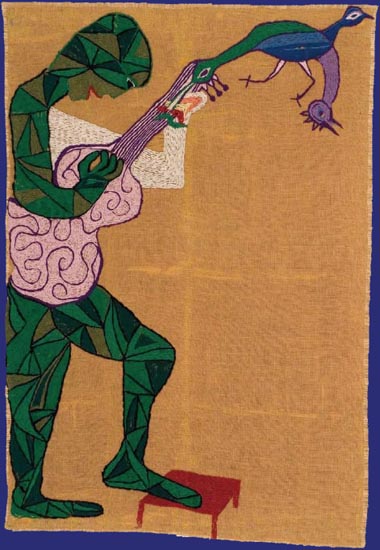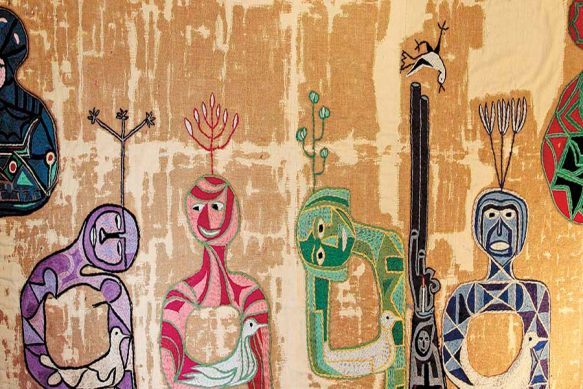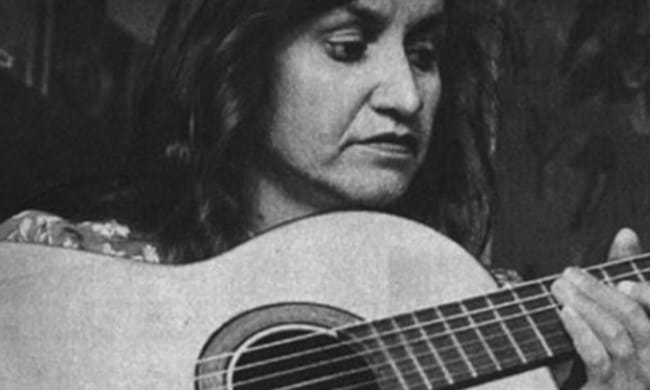Violeta Parra: between life and pain
Violeta Parra fue una gran canta autora chilena que desafió los estereotipos de su tiempo. Fue un pilar de la música popular chilena y una inspiración para toda la música protesta de América del Sur.
Original content by IPS

Solitary, unfinished and defiant, like its own creator, an applique of 136 by 200 centimetres, escorted by song lyrics, pays tribute to Chilean singer-songwriter Violeta Parra on the centennial of her birth through the exhibition “Tealabo, amiga, compañera” at Havana’s Casa de lasAméricas.
The exibit’s guards tell me that this is a work Violeta was planning on donating to the Cuban institution and which she never finished. The date is 1996, a year before she put an end to her life on a February evening with a shot to her head.
The tribute to this great of Latin American music and arts is taking place in the context of the Musical Composition Prize which on the day it was inaugurated also presented two themes of the composer and singer: “El día de tucumpleaños” and “MazúrquicaModerna.”

According to one of the jury members from Chile, Boris Alvarado, “every once in a while the Parra family gives to the world Violeta’s unpublished works. Recently two new themes saw the public light with the condition that they have a less popular treatment.”
Alvarado adds thatthese two works would have world premieres in May in Chile, but thatwith the authorisation of the National Council of Culture and the Arts of the Andean-dufford nation, it was decided to have the premiere in Havana, in the context of the Musical Composition Prize and in choral versions.
And it is more than just that the tribute for her who when asked which of the artistic manifestations she cultivated she would choose, she answered: “I would choose to stay with the people” despite the contradictory decision of putting an end to her life which according to her own words had given her so much.
Those who knew her say that she had a strong personality, was against making concessions and was absolutely incapable of giving herself a minute of rest. This is confirmed by her tireless manifestations as a singer, poet, composer, sculptor, embroiderer, ceramicist and mother of four children, with two (Angel and Isabel) of whom she formed a group to make known all of her country’s folkloric wealth.
The first of her vocations was singing. When she was nine years old she taught herself how to play the guitar and at 12 she started composing her first songs.
Violeta’s visual work mainly comprises appliques and oil paintings on canvas, wood and cardboard. Her themes are those of daily life: the family, childhood memories and parts of history. They were created between 1954 and 1965 in Santiago, Chile, Buenos Aires, Paris and Geneva, and have been exhibited in several of the world’s museums.
In fact, this universal Chilean was the first to display her visual work in the Louvre Museum, in Paris, a city where she also recorded her first LPs with folklore and original songs.
Foreign singers of diverse genres like Mercedes Sosa, Franco Simona and Plácido Domingo include Violeta Parra’s songs in their repertoires while books, films and exhibitions keep alive the legacy of a woman who was traditional and a pioneer at the same time, and as vanguard as popular.
It is said that it was her brother, the great poet Nicanor, who encouraged her to travel through the rural zones of Chile to record and collect her folkloric music. In that sense she said: “anyone can make songs and express themselves in the way that’s most comfortable to them.”
This vocation to make known the voice of the most underprivileged and her unmistakable social criticism in a great deal of her compositions has led to her being considered the initiator of what is considered the New Chilean Song.

But Violeta also wrote unforgettable love and loveless songs, a result of a complicated life with respect to her couples. It’s easy to guess that a woman like her would have difficulties to be understood and backed in her mission of embellishing the world that, however, seemed hostile judging by her bleak texts.
Months before putting an end to her life and as a result of the release of what would be her last record, Parra said to a journalist: “I’m missing something, I don’t know what. I’m looking for it and I don’t find it. I will surely never find it.”
This unhappiness did not hold her back to bequeath us some of the most valuable works of Latin America’s cultural heritage.
At present, even rock musicians recognise the depth of her music that the Violeta Parra Foundation now spreads and protects. In 1993 that entity published the collection of her songs under the title Virtud de los elementos which includes some 70 compositions and has an introduction by none other than Cuban singer-songwriter Silvio Rodríguez.
When I was young I used to listen a lot to Violeta Parra. In Cuba her presence has been permanent much more with the visits of her children Angel and Isabel almost always convened by Casa de Las Américas.
Then of course it is fair that this institution be the one that reminds us that this year Violeta would have been celebrating her 100th anniversary always thanking life for so much it had given her but which she considered insufficient.
Fortunately, she said, I have “a guitar/to cry my pain.” (2017)


